
Posted on 08/04/2017 8:35:15 PM PDT by TigerLikesRooster
Startling new scientific evidence is to be reviewed by international experts which - if true - would transform our knowledge of the skills and sophistication of early man.
A stunning discovery by team of Novosibirsk Institute of Archeology and Ethnography. Picture: Anatoly Derevyanko
It is already known as the oldest stone bracelet in the world, believed to have been made not by ancient Homo sapiens but the extinct Denisovan species of early humans, and previously dated as being between 40,000 - 50,000 years old.
The bracelet was found in 2008 in so-called Stratum 11 of world famous Denisova cave in the Altai region of Siberia.
New findings suggest it could be 65,000 to 70,000 years old, long before ancient people were believed to capable of making such remarkable objects.
Maksim Kozlikin, a researcher form the Institute of Archeology and Ethnography, Novosibirsk, indicated Australian specialists were among those to obtain exceptional results on the bracelet's age.
'Preliminary results have been received to date Stratum 11 where the bracelet was found to 65,000-to-70,000 years,' he said.
'So it all goes towards changing the dating of the find to more ancient.'
It is understood that further checks were made, and the results were 'verified and verified again', according to one Russian report, citing scientists involved with the bracelet.
'Scientists are certain that multiple big headlines are coming up,' reported Novosibirsk TV Channel 10.
This month experts from Russia will meet scientists from the University of Wollongong in Australia, and University of Oxford in the UK.
Professor Mikhail Shunkov, director of the Institute of Archeology and Ethnography, said: 'Our colleagues from Australia and Oxford are coming here in August, we will be discussing the dating then.'
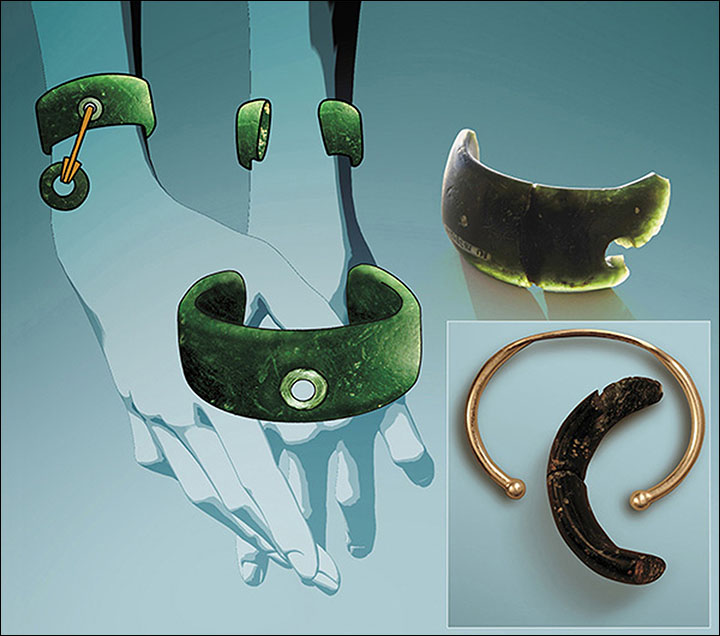
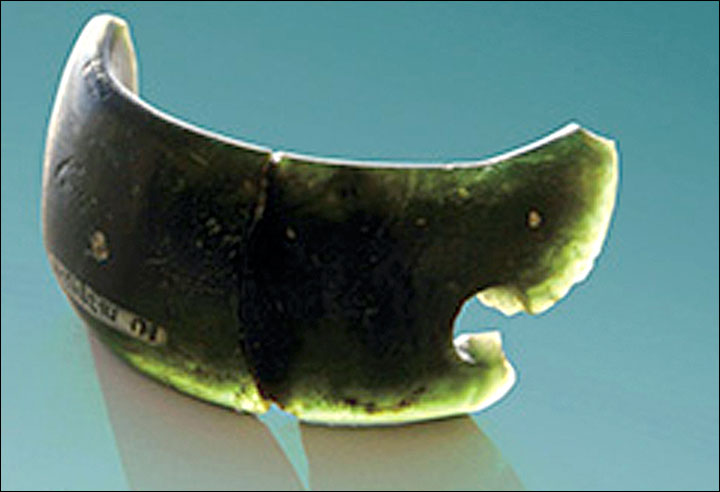
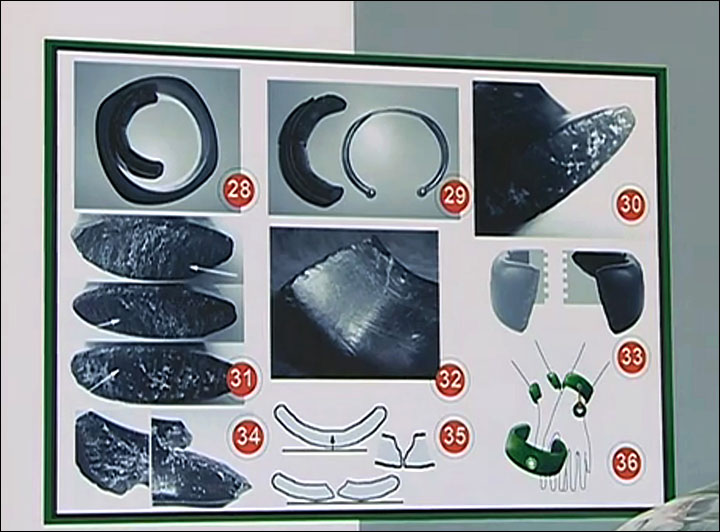
'The bracelet is stunning - in bright sunlight it reflects the sun rays, at night by the fire it casts a deep shade of green'. Pictures: Anatoly Derevyanko, Konstantin Tynayev
The bracelet was exhibited in Paris this year, carrying a label showing it to be 50,000 years old with the approval of scientists.
'Made 50,000 ago, for this kind of object and with the (known) level of technologies... this is (already) a world-level phenomenon,' said Dr Shunkov.
He said consensus on the age would be announced after the experts had discussed the dating, and that a major scientific journal study was expected.
'Until then, I will refrain saying anything,' he said, adding that some data was 'ambiguous' and required clarification.
'If or when we agree, we will have to prepare a publication first,' he said.

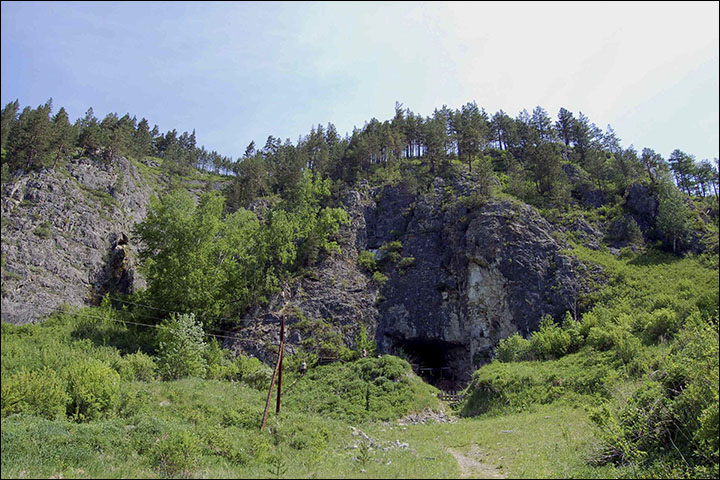
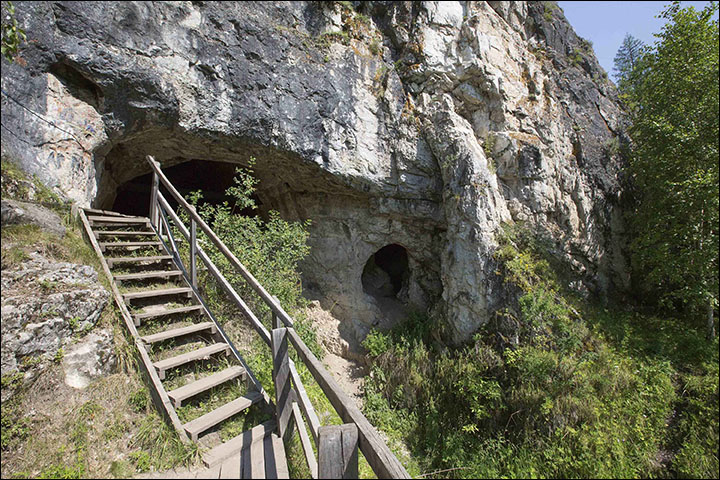
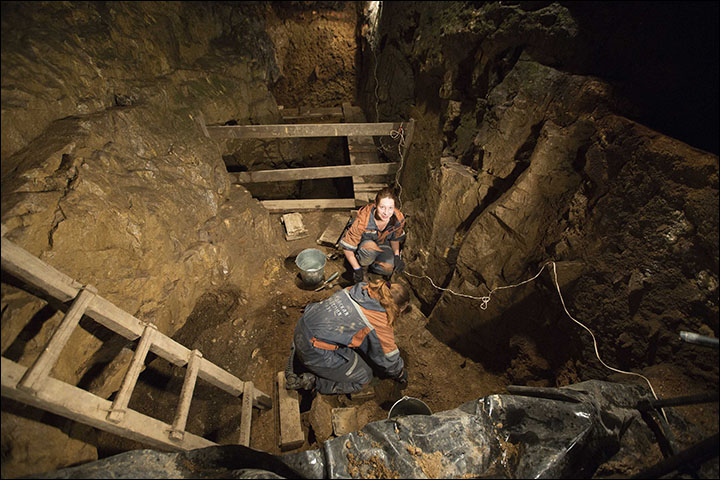
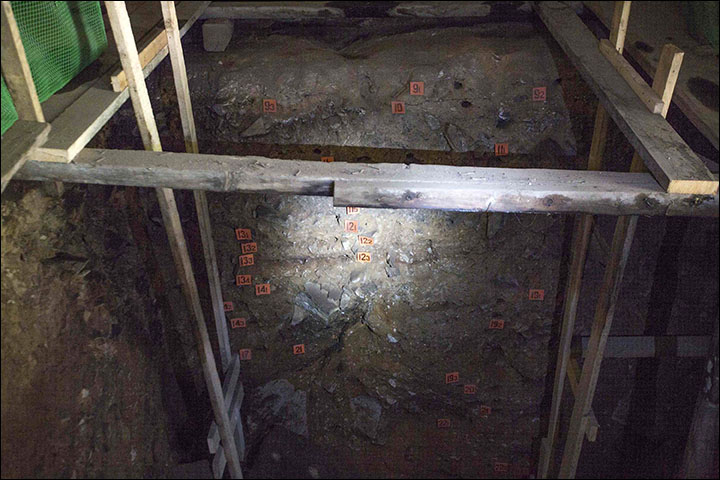
Dr Shunkov and Denisova Cave in The Altai Mountains. Pictures: The Siberian Times
Efforts by The Siberian Times to reach the Australian scientists on their dating work were unsuccessful.
The bracelet is thought to have adorned a very important woman or child on only special occasions.
Scientists conclude it was made by our prehistoric human ancestors, the Denisovans, and shows them to have been far more advanced than ever realised.
'The bracelet is stunning - in bright sunlight it reflects the sun rays, at night by the fire it casts a deep shade of green,' said Professor Anatoly Derevyanko, the institute's former director.
'It is unlikely it was used as an everyday jewellery piece. I believe this beautiful and very fragile bracelet was worn only for some exceptional moments,' he said.
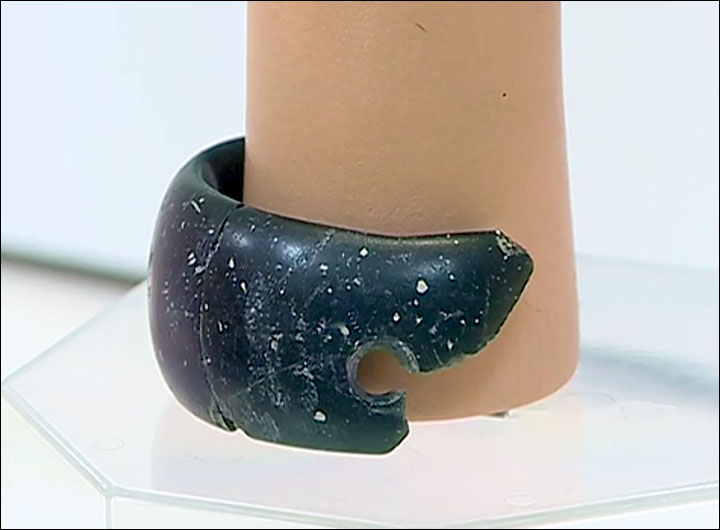
What made the discovery especially striking was that the manufacturing technology is more common to a much later period, such as the Neolithic era. Picture: Konstantin Tynayev
The bracelet was found inside the famous Denisova Cave, in the Altai Mountains, which is renowned for its palaeontological finds dating back to the Denisovans, known as homo altaiensis, an extinct species of humans genetically distinct from Neanderthals and modern humans.
Made of chlorite, the bracelet was found in the same layer as the remains of some of the prehistoric people and is thought to belong to them.
What made the discovery especially striking was that the manufacturing technology is more common to a much later period, such as the Neolithic era.
Indeed, it is not clear yet how the Denisovans could have made the bracelet with the skills they had.
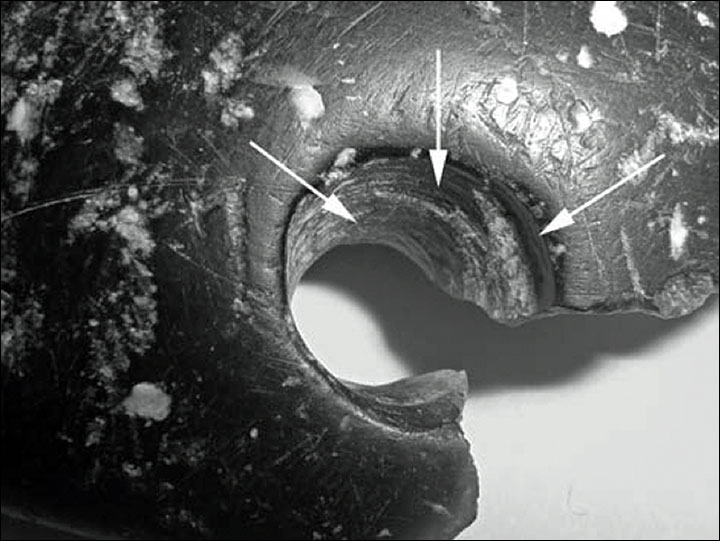
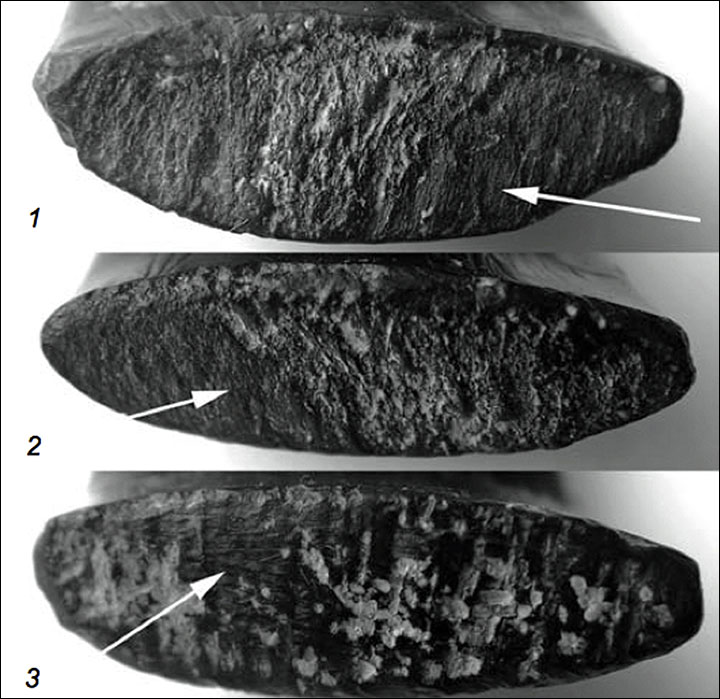
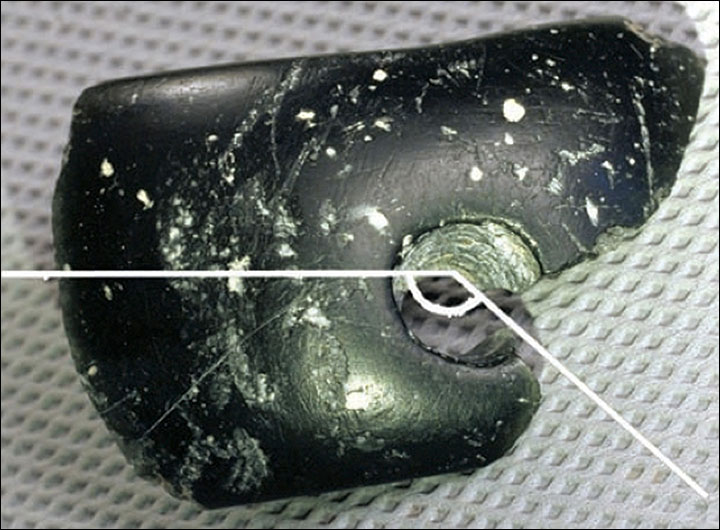
'Next to the hole on the outer surface of the bracelet can be seen clearly a limited polished zone of intensive contact with some soft organic material,' said Dr Derevyanko. Pictures: Anatoly Derevyanko
Writing in the Novosibirsk magazine, Science First Hand, Dr Derevyanko said: 'Two fragments of the bracelet of a width of 2.7cm and a thickness of 0.9 cm were found. The estimated diameter of the find was 7cm.
'Near one of the cracks was a drilled hole with a diameter of about 0.8 cm. Studying them, scientists found out that the speed of rotation of the drill was rather high, fluctuations minimal, and that was there was applied drilling with an implement - technology that is common for more recent times.
'The ancient master was skilled in techniques previously considered not characteristic for the Paleolithic era, such as drilling with an implement, boring tool type rasp, grinding and polishing with a leather and skins of varying degrees of tanning.'
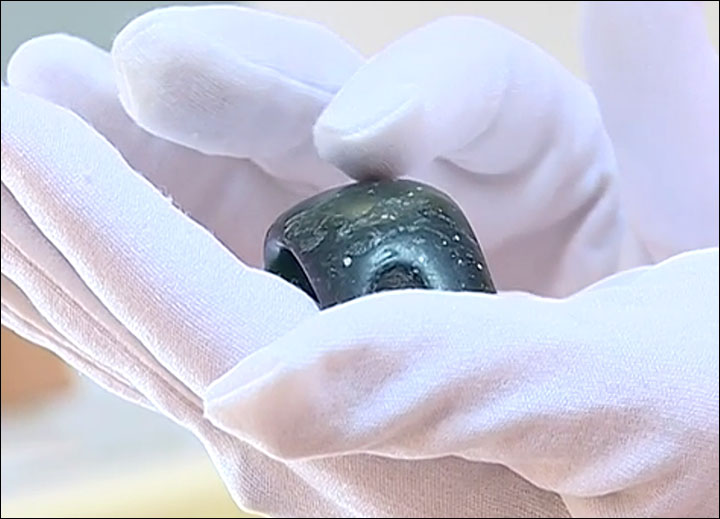
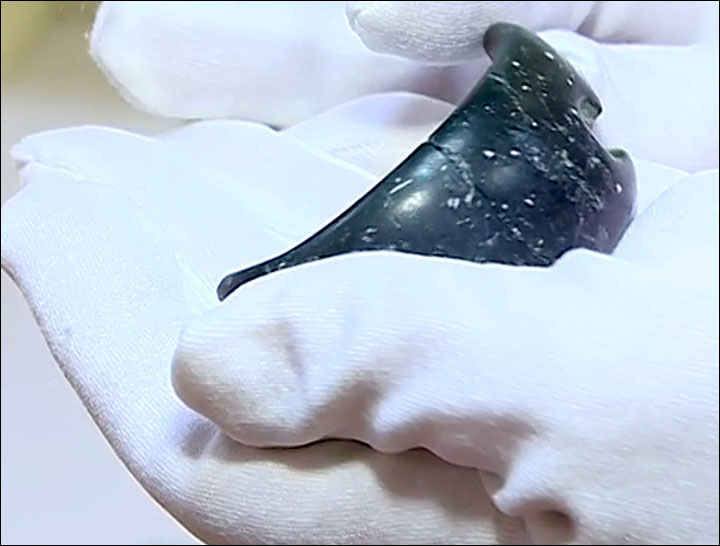
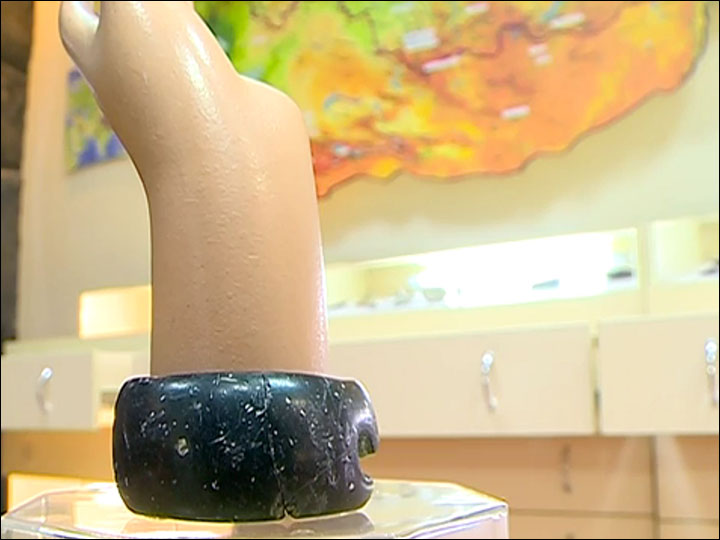
Сonsensus on the age would be announced after the experts had discussed the dating, and that a major scientific journal study was expected. Pictures: Konstantin Tynayev
Chlorite was not found in the vicinity of the cave, and is thought to have come from a distance of at least 200km, showing how valued the material was at the time.
Dr Derevyanko said the bracelet had suffered damage, including visible scratches and bumps although it looked as if some of the scratches had been sanded down.
Experts also believe that the piece of jewellery had other adornments to make it more beautiful.
'Next to the hole on the outer surface of the bracelet can be seen clearly a limited polished zone of intensive contact with some soft organic material,' said Dr Derevyanko.
'Scientists have suggested that it was a leather strap with some charm, and this charm was rather heavy.
'The location of the polished section made it possible to identify the 'top' and 'bottom' of the bracelet and to establish that it was worn on the right hand.'
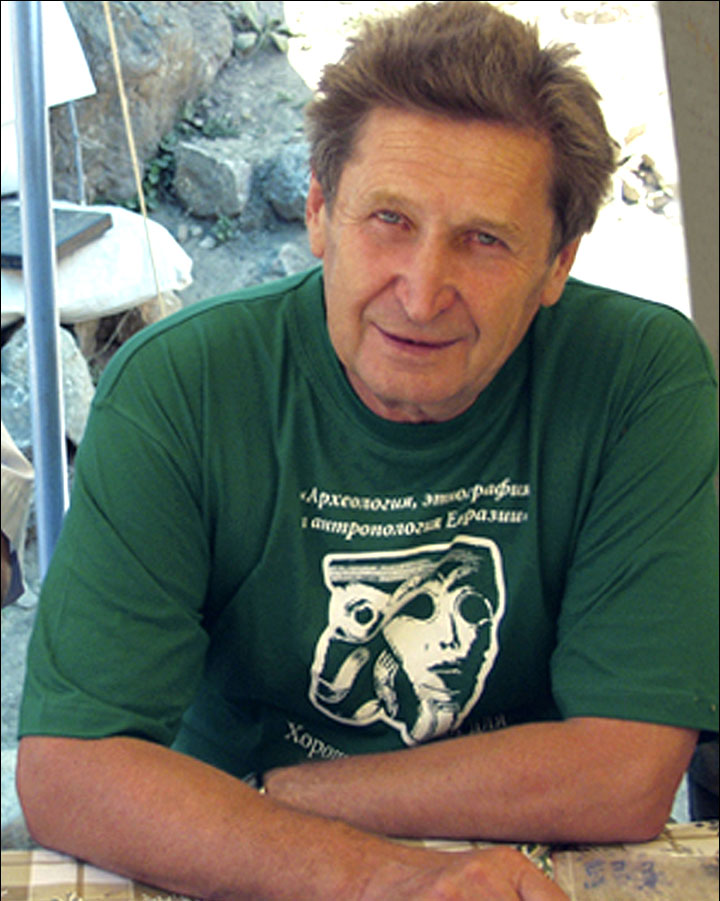
Professor Anatoly Derevyanko, former director of Novosibirsk Institute of Archeology and Ethnography
Redating the age of the bracelet would also mean other items found in the same layer were also older.
A striking example is a Paleolithic needle now dated at 50,000 years.
This is also seen as be made by the extinct Denisovans.
Located some 150 km south of Barnaul, the the cave has immense palaeontological importance.
Over the years a number of remains have been found there, including some of extinct animals such as the woolly mammoth. In total evidence of 66 different types of mammals have been discovered inside, and 50 bird species.
The most exciting discovery was the remains of the Denisovans, a species of early humans that dated back as early as 600,000 years ago and were different to both Neanderthals and modern man.
In 2000 a tooth from a young adult was found in the cave and in 2008, when the bracelet was found, archaeologists discovered the finger bone of a juvenile Denisovan hominin, whom they dubbed the 'X woman'.
Further examination of the site found other artifacts dating as far back as 125,000 years.
Dr Shunkov has suggested that the bracelet indicates the Denisovans - though now extinct - were more advanced than Homo sapiens and Neanderthals.
'In the same layer, where we found a Denisovan bone, we found interesting things; until then it was believed these the hallmark of the emergence of Homo sapiens,' he said.
'First of all, there were symbolic items, such as jewellery - including the stone bracelet as well as a ring, carved out of marble.'
'These finds were made using technological methods - boring stone, drilling with an implement, grinding - that are traditionally considered typical for a later time, and nowhere in the world they were used so early, in the paleolithic era. At first, we connected the finds with a progressive form of modern human, and now it turned out that this was fundamentally wrong.
'Obviously it was Denisovans, who left these things.'
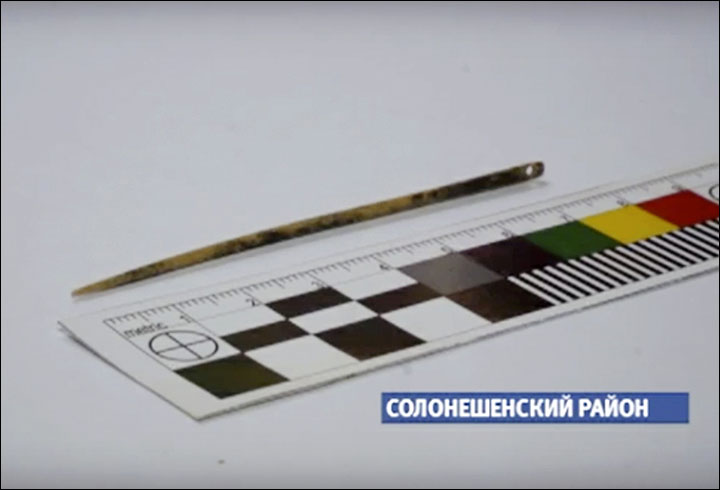

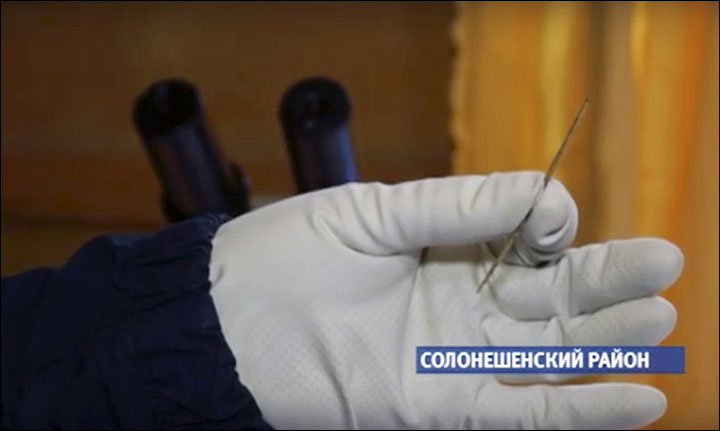
The 7 centimetre (2 3/4 inch) needle was made and used by our long extinct Denisovan ancestors
This indicated that 'the most progressive of the triad' (Homo sapiens, Homo Neanderthals and Denisovans) were Denisovans, who according to their genetic and morphological characters were much more archaic than Neanderthals and modern human.'
But could this modern-looking bracelet have been buried with older remains, perhaps dug into the cave floor in a later era to hide it?
The experts considered this possibility but rejected it, saying they believe the layers were uncontaminated by human interference from a later period. The soil around the bracelet was also dated using oxygen isotopic analysis.
The unique bracelet is now held by the Museum of History and Culture of the Peoples of Siberia and the Far East in Novosibirsk.
Irina Salnikova, head the museum, said of the bracelet: 'I love this find. The skills of its creator were perfect. Initially we thought that it was made by Neanderthals or modern humans, but it turned out that the master was Denisovan, at least in our opinion.'
Text of article, un-****ified.
Startling new scientific evidence is to be reviewed by international experts which -- if true -- would transform our knowledge of the skills and sophistication of early man.
A stunning discovery by team of Novosibirsk Institute of Archeology and Ethnography. Picture: Anatoly Derevyanko
It is already known as the oldest stone bracelet in the world, believed to have been made not by ancient Homo sapiens but the extinct Denisovan species of early humans, and previously dated as being between 40,000 -- 50,000 years old.
The bracelet was found in 2008 in so-called Stratum 11 of world famous Denisova cave in the Altai region of Siberia.
New findings suggest it could be 65,000 to 70,000 years old, long before ancient people were believed to capable of making such remarkable objects.
Maksim Kozlikin, a researcher form the Institute of Archeology and Ethnography, Novosibirsk, indicated Australian specialists were among those to obtain exceptional results on the bracelet's age.
'Preliminary results have been received to date Stratum 11 where the bracelet was found to 65,000-to-70,000 years,' he said.
'So it all goes towards changing the dating of the find to more ancient.'
It is understood that further checks were made, and the results were 'verified and verified again', according to one Russian report, citing scientists involved with the bracelet.
'Scientists are certain that multiple big headlines are coming up,' reported Novosibirsk TV Channel 10.
This month experts from Russia will meet scientists from the University of Wollongong in Australia, and University of Oxford in the UK.
Professor Mikhail Shunkov, director of the Institute of Archeology and Ethnography, said: 'Our colleagues from Australia and Oxford are coming here in August, we will be discussing the dating then.'
'The bracelet is stunning -- in bright sunlight it reflects the sun rays, at night by the fire it casts a deep shade of green'. Pictures: Anatoly Derevyanko, Konstantin Tynayev
The bracelet was exhibited in Paris this year, carrying a label showing it to be 50,000 years old with the approval of scientists.
'Made 50,000 ago, for this kind of object and with the (known) level of technologies... this is (already) a world-level phenomenon,' said Dr Shunkov.
He said consensus on the age would be announced after the experts had discussed the dating, and that a major scientific journal study was expected.
'Until then, I will refrain saying anything,' he said, adding that some data was 'ambiguous' and required clarification.
'If or when we agree, we will have to prepare a publication first,' he said.
Dr Shunkov and Denisova Cave in The Altai Mountains. Pictures: The Siberian Times
Efforts by The Siberian Times to reach the Australian scientists on their dating work were unsuccessful.
The bracelet is thought to have adorned a very important woman or child on only special occasions.
Scientists conclude it was made by our prehistoric human ancestors, the Denisovans, and shows them to have been far more advanced than ever realised.
'The bracelet is stunning -- in bright sunlight it reflects the sun rays, at night by the fire it casts a deep shade of green,' said Professor Anatoly Derevyanko, the institute's former director.
'It is unlikely it was used as an everyday jewellery piece. I believe this beautiful and very fragile bracelet was worn only for some exceptional moments,' he said.
What made the discovery especially striking was that the manufacturing technology is more common to a much later period, such as the Neolithic era. Picture: Konstantin Tynayev
The bracelet was found inside the famous Denisova Cave, in the Altai Mountains, which is renowned for its palaeontological finds dating back to the Denisovans, known as homo altaiensis, an extinct species of humans genetically distinct from Neanderthals and modern humans.
Made of chlorite, the bracelet was found in the same layer as the remains of some of the prehistoric people and is thought to belong to them.
What made the discovery especially striking was that the manufacturing technology is more common to a much later period, such as the Neolithic era.
Indeed, it is not clear yet how the Denisovans could have made the bracelet with the skills they had.
'Next to the hole on the outer surface of the bracelet can be seen clearly a limited polished zone of intensive contact with some soft organic material,' said Dr Derevyanko. Pictures: Anatoly Derevyanko
Writing in the Novosibirsk magazine, Science First Hand, Dr Derevyanko said: 'Two fragments of the bracelet of a width of 2.7cm and a thickness of 0.9 cm were found. The estimated diameter of the find was 7cm.
'Near one of the cracks was a drilled hole with a diameter of about 0.8 cm. Studying them, scientists found out that the speed of rotation of the drill was rather high, fluctuations minimal, and that was there was applied drilling with an implement -- technology that is common for more recent times.
'The ancient master was skilled in techniques previously considered not characteristic for the Paleolithic era, such as drilling with an implement, boring tool type rasp, grinding and polishing with a leather and skins of varying degrees of tanning.'
ëonsensus on the age would be announced after the experts had discussed the dating, and that a major scientific journal study was expected. Pictures: Konstantin Tynayev
Chlorite was not found in the vicinity of the cave, and is thought to have come from a distance of at least 200km, showing how valued the material was at the time.
Dr Derevyanko said the bracelet had suffered damage, including visible scratches and bumps although it looked as if some of the scratches had been sanded down.
Experts also believe that the piece of jewellery had other adornments to make it more beautiful.
'Next to the hole on the outer surface of the bracelet can be seen clearly a limited polished zone of intensive contact with some soft organic material,' said Dr Derevyanko.
'Scientists have suggested that it was a leather strap with some charm, and this charm was rather heavy.
'The location of the polished section made it possible to identify the 'top' and 'bottom' of the bracelet and to establish that it was worn on the right hand.'
Professor Anatoly Derevyanko, former director of Novosibirsk Institute of Archeology and Ethnography
Redating the age of the bracelet would also mean other items found in the same layer were also older.
A striking example is a Paleolithic needle now dated at 50,000 years.
This is also seen as be made by the extinct Denisovans.
Located some 150 km south of Barnaul, the the cave has immense palaeontological importance.
Over the years a number of remains have been found there, including some of extinct animals such as the woolly mammoth. In total evidence of 66 different types of mammals have been discovered inside, and 50 bird species.
The most exciting discovery was the remains of the Denisovans, a species of early humans that dated back as early as 600,000 years ago and were different to both Neanderthals and modern man.
In 2000 a tooth from a young adult was found in the cave and in 2008, when the bracelet was found, archaeologists discovered the finger bone of a juvenile Denisovan hominin, whom they dubbed the 'X woman'.
Further examination of the site found other artifacts dating as far back as 125,000 years.
Dr Shunkov has suggested that the bracelet indicates the Denisovans -- though now extinct -- were more advanced than Homo sapiens and Neanderthals.
'In the same layer, where we found a Denisovan bone, we found interesting things; until then it was believed these the hallmark of the emergence of Homo sapiens,' he said.
'First of all, there were symbolic items, such as jewellery -- including the stone bracelet as well as a ring, carved out of marble.'
'These finds were made using technological methods -- boring stone, drilling with an implement, grinding -- that are traditionally considered typical for a later time, and nowhere in the world they were used so early, in the paleolithic era. At first, we connected the finds with a progressive form of modern human, and now it turned out that this was fundamentally wrong.
'Obviously it was Denisovans, who left these things.'
The 7 centimetre (2 3/4 inch) needle was made and used by our long extinct Denisovan ancestors
This indicated that 'the most progressive of the triad' (Homo sapiens, Homo Neanderthals and Denisovans) were Denisovans, who according to their genetic and morphological characters were much more archaic than Neanderthals and modern human.'
But could this modern-looking bracelet have been buried with older remains, perhaps dug into the cave floor in a later era to hide it?
The experts considered this possibility but rejected it, saying they believe the layers were uncontaminated by human interference from a later period. The soil around the bracelet was also dated using oxygen isotopic analysis.
The unique bracelet is now held by the Museum of History and Culture of the Peoples of Siberia and the Far East in Novosibirsk.
Irina Salnikova, head the museum, said of the bracelet: 'I love this find. The skills of its creator were perfect. Initially we thought that it was made by Neanderthals or modern humans, but it turned out that the master was Denisovan, at least in our opinion.'
First, the piece is made of chlorite, which is extremely soft as stones go. It's 2 to 2.5 on the Mohs hardness scale, which means it could very easily be fashioned by stone tools with greater hardness which abound. And the ancients were stone-age people with a very clear understanding of the properties of rocks.
Artistic ability isn't confined to just us moderns. Consider the extraordinary cave paintings done by ancient cultures, evidence of the great skill of artists who were only "primitive" in terms of the technology available to them. I see no reason those artistic perceptions couldn't extend to three dimensions, as they no doubt did with this bracelet.
Bottom line: in terms of lapidary considerations I see no reason why the bracelet could not have been made at the time suggested.
Thanks, and well put!
WOW. I really enjoyed this article.
I wonder, if it was such a fancy possession, might somebody from 10,000 years ago (or whenever) - dug a deep hole to bury it for safekeeping, and was never able to retrieve it later? And now we find it in a deeper layer dated at 70,000 years old?
Or they built spacecraft a thousand years later and left already. :)

Disclaimer: Opinions posted on Free Republic are those of the individual posters and do not necessarily represent the opinion of Free Republic or its management. All materials posted herein are protected by copyright law and the exemption for fair use of copyrighted works.